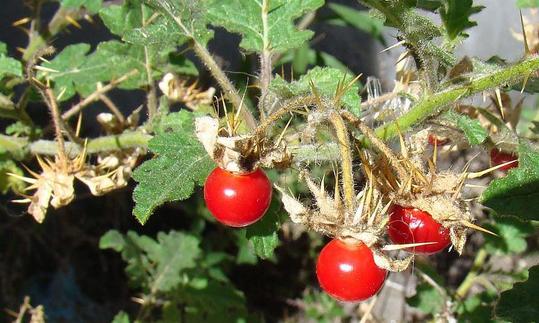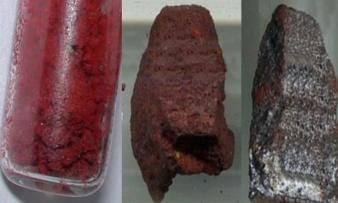Table of contents
Lychee tomatoes ( litchi tomatoes) are the fruits of the nightshade ( Solanum sisymbriifolium). The plant with cherry-sized berries that are red when ripe is also called Morelle de Balbis. These do not taste like tomatoes, but more like sour cherries and are not related to the lychee ( Litchi chinensis).
Use in the kitchen
The round fruits of the lychee tomato (also known as litchi tomato) ripen to a strong red color. The inner flesh is yellow, with tiny flat seeds that are numerous and arranged like a cherry tomato. 16 The taste of a lychee tomato is sweet and refreshing at the same time and is reminiscent of sour cherries, physalis and melons. In terms of consistency, the lychee tomato (litchi tomato) is similar to a physalis.
The ripe lychee tomatoes can be eaten raw (and preferably organic) straight from the bush; or you can prepare a healthy raw vegetable salad or fruit salad. Their fruity note makes them interesting as a vegan snack, aperitif or for desserts such as sorbets or fruit cakes.
If you have a large amount of lychee tomatoes, you can press them raw to make fruit juice, or you can boil them down to make jam or compote. Their sweet and sour flavor also goes well in a chutney.
Vegan lychee tomato recipe for a spicy chutney
Ingredients for approx. 4 jars (350 ml each): 4 cups chopped green tomatoes (your own variety, do not use unripe ones!) - alternatively: red tomatoes, 2½ cups peeled lychee tomatoes (raw, organic), 6 pitted and chopped dates, 4 finely chopped garlic cloves, zest of 2 limes, 1-2 finely chopped chilies, ½ cup white balsamic vinegar, 2 tsp ground mustard seeds, 1 tsp fennel seeds, ½ tsp ground cinnamon, 1 tsp cumin, 1 cup green (or "classic") raisins, 1 chopped mango, 1 cup almond slivers, 1 cup honey (according to preferred sweetness; we recommend less).
Preparation : Put all the ingredients in a saucepan and cook over medium heat for about 20 minutes until the mixture has a thick consistency. Then remove the pan from the heat and use a slotted spoon to evenly distribute the fruit mixture between the jars. The liquid should remain in the pan. Place the jars in hot water without sealing them so that the contents stay warm. Meanwhile, reduce the remaining juice over high heat until it has thickened and is as viscous as honey. Now fill the jars with the thick juice and seal them tightly. Allow the vegan chutney to mature in the jar for about 2 weeks before using.
| Not only vegans or vegetarians should read this: Vegans often eat unhealthily. Avoidable nutritional mistakes. |
Purchasing - Storage
Lychee tomatoes are rarely available in supermarkets in Europe such as Coop, Migros, Denner, Volg, Spar, Aldi, Lidl, Rewe, Edeka, Hofer, Billa. Organic supermarkets such as Denn's Biomarkt and Alnatura also do not stock lychee tomatoes.
You can buy lychee tomato plants. Garden shops and the Internet also offer seeds from lychee tomatoes that you can grow yourself in the spring. This way you can harvest your own red organic lychee tomatoes, depending on your location from August to October. 1
Storage tips
It is advisable to consume freshly harvested lychee tomatoes quickly, as they do not keep for long. Some growers recommend storing them in the refrigerator (wrapped in a paper bag). Freezing changes the consistency and is only suitable if you want to make jam or sauce later.
Ingredients - nutritional values - calories
According to a study (2021) 3, ripe lychee tomatoes contain around 13% fat and 19% protein. Information on the sugar content and thus the total amount of carbohydrates is missing - as is the total energy (kcal). The crude fiber content ( fiber) is around 12%, about the same as in spelt or oats. 4
Ripe lychee tomatoes contain 31 mg/100g of magnesium, which is similar to that found in raw chestnuts (32 mg/100g) or baby zucchinis (33 mg/100g). 4
The potassium content of a ripe lychee tomato is only about 16 mg/100g, which, like rice milk (16 mg), only accounts for 1% of the daily requirement. 4
The calcium content of 6.7 mg/100g is similar to that of sweet peppers (red) and tomatillos (mountain eggplant), which have 7 mg/100g. 4
Further ingredients of raw lychee tomatoes, coverage of the daily requirement and comparison values with other ingredients can be found in our nutrient tables below the ingredient image.
Effects on health
How healthy are lychee tomatoes? In Paraguayan folk medicine, the roots of the lychee tomato are used as a remedy for high blood pressure. The blood pressure-lowering effect of root extracts has been confirmed by studies (on rats). 7,18
Secondary plant substances
Many of the health benefits of lychee tomatoes can be attributed to the secondary plant substances they contain. Our article on secondary plant substances provides an overview of the classification of substance groups, their occurrence in foods and possible effects on humans. Lychee tomatoes contain the following secondary plant substances, among others: 6,16,18
- Isoprenoids: Triterpenes: Steroidal saponins (Isonuatigenin-3- O - β -solatriose, Nuatigenin-3-0- β -chacotriose), Steroids (Campesterol), Saponins (Spirostan: Nuatigenosido); Tetraterpenes: Carotenoids (Carotene: Beta-carotene, Lutein; Xanthophylls: Zeaxanthin)
- Alkaloids: Steroid alkaloids (solasodine, solamargine, beta-solamarine); glycoalkaloids (solacaproín, solanine, solasodine); Pyrrolidine alkaloids (Cuscohygrin)
- Polyphenols: Phenolic acids: Hydroxycinnamic acids (chlorogenic acid, dihydrocaffeic acid, ferulic acid, caffeic acid); flavonoids: flavonols (rutin, kaempferol-3-rutinose); anthocyanins (pelargonidin); lignans: sisymbridin, neolignan
- Nitrogen-containing compounds: amines (choline)
However, it should be noted that the composition of secondary plant substances in lychee tomatoes can vary depending on the variety, time of harvest and growing conditions. Therefore, quantities are only of limited use and should only be understood roughly.
The steroidal saponins contained in the roots of Solanum sisymbriifolium have an inhibitory effect against the yellow fever virus and a virucidal effect against types of the dengue virus. Researchers therefore hope to be able to use the saponins from lychee tomatoes to develop antiviral agents against these and other viruses. 6
The steroid alkaloid solasodine, isolated from the fruit of the lychee tomato, is said to have an anti-oxidative and anti-inflammatory effect as well as an anti-tumor effect. Studies have already shown that solasodine has inhibitory effects against liver cancer, lung cancer and esophageal cancer. 18 In addition, research (using animal models) has shown that solasodine (isolated from dried berries) has an anti-epileptic and central nervous system depressant effect. 9,18
Dangers - Intolerances - Side effects
Unripe fruits of the lychee tomato as well as germs and leaves contain toxic alkaloids (including solanine 18) and are poisonous. 3,5,17 Therefore, one should only eat ripe (red) berries of the rocket-leaved nightshade, not green or yellow-orange fruits. Ripe lychee tomatoes can be picked without much resistance. Eating unripe fruits of the prickly tomato plant leads to nausea, vomiting, severe stomach pain and even circulatory and respiratory collapse. In severe cases, mental confusion and severe headaches occur. 5
Risk of confusion
There is a particularly high risk of confusion with the Carolina nightshade ( Solanum carolinense), also known as horse nettle, which is widespread in the southern USA. This is poisonous to humans and animals and can be dangerous, especially for grazing cattle, when dried. 14 This plant has slightly smaller, yellow-orange berries that contain alkaloids and are therefore toxic. In Switzerland , Solanum carolinense is considered a neophyte with invasive potential, which is subject to an obligation to provide information. 15
Folk medicine - naturopathy
In traditional folk medicine in India, Solanum sisymbriifolium is used to treat high blood pressure, diarrhea, respiratory diseases and various disorders of the central nervous system, such as epilepsy and depression. 9 In South America, folk medicine uses parts of the plant and roots more frequently than the berries (the study cited 18 also adds known effects as a contraceptive, against fever and urinary tract infections).
Ecological footprint - animal welfare
Despite extensive research, we were unable to find any precise figures on the ecological footprint of lychee tomatoes. We also did not read any precise information on the water footprint.
The resistance to many pests and diseases makes the lychee tomato interesting for agricultural research (especially in organic farming). There it is used as a bait plant (catch plant) for nematodes and fungi in potato cultivation. 11 There is debate as to whether the deliberate cultivation of the rocket-leaved nightshade ( Solanum sisymbriifolium) in the field should risk invasive spread. 12
Once established, the nightshade is difficult to get rid of. The lychee tomato spreads very quickly, mainly by seed (about 45,000 seeds per year), but also by root suckers (rhizomes) and with the help of animals or human activity. Solanum sisymbriifolium often forms dense thickets of thorns and crowds out native vegetation, which is why the plant has been included in the Global Compendium of Weeds. In some countries, such as Australia, South Africa, the USA, Cuba, Hungary, Italy, Spain, China and Japan, it is considered a harmful invasive weed. 13
For detailed explanations of various sustainability indicators (such as ecological footprint, CO2 footprint, water footprint), see our article: What does the ecological footprint mean?
Worldwide occurrence - cultivation
The lychee tomato plant (Nightshade) originates from South America. There it grows mainly in sandy places such as roadsides, along fences or in similar places. It then multiplies quickly because the prickly defense protects it from predators. 10
The lychee tomato now also grows outside its native region, is almost invasive and is almost impossible to control. Occasionally you see the shrub with the beautiful white to violet flowers planted as an ornamental plant in hedges, as the thorns deter animals from wandering into vegetable gardens. In Central Europe, the nightshade does not survive the winter outdoors and is considered an annual plant. 10
Found in the wild
In tropical and subtropical areas, the plant inhabits less protected areas, such as roadsides, burned areas and fallow land. 2
Growing your own - Harvesting
If you want to grow the lychee tomato yourself, plant it in a larger pot. The perennial shrub thrives even better in the greenhouse, but propagation via remaining seeds and rhizomes can also lead to problems.
The ideal location is sunny and protected from rain, the soil should always be moist but not waterlogged. Lychee tomatoes need permeable, nutrient-rich soil, preferably compost, which is regularly enriched with organic tomato fertilizer. 2
The lychee tomato has large white, sometimes delicate lilac-colored flowers with bright yellow pollen leaves. The leaves, stems and calyxes have sticky hairs - but they also have hard spines. A prickly fruit shell encloses the small fruits. 2 When the fruits begin to ripen, the fruit shell recedes. When harvesting, wear gloves and do not pull on the red berries, but twist the ripe fruits from the stem. Depending on the quality of the soil and care, the bush can grow up to two meters high. Each fruit contains 50-200 seeds and has a thicker skin than a cherry tomato. Lychee tomatoes are climacteric, which means that fruits that are not fully ripe will continue to ripen (not the green ones!). 1
The plants require winter temperatures between 7 and 12 °C. Otherwise, we recommend buying seeds for lychee tomatoes or obtaining them directly from the harvested fruit for sowing next year. 2 To do this, remove the seeds of the lychee tomato from the fruit and let them dry for a few days. The cultivation can be compared to that of tomatoes: at the end of March or beginning of April, the young plants are grown indoors. As soon as the nights are frost-free, they are transplanted outside. Fortunately, you can save yourself the trouble of thinning out the plants. 1
Further information
Like the potato, the eggplant and the tomato, the lychee tomato ( Solanum sisymbriifolium) belongs to the nightshade family (Solanaceae). It is one of the seven subgenera of the nightshade, the subgenus Leptostemonum, whose typical characteristics are the spines on the stem, on the leaves and/or on the calyx. It is more closely related to the eggplant than to the tomato.
Are lychee tomatoes a fruit or a vegetable? From a botanical point of view, lychee tomatoes are berries (as are tomatoes). Since the clear classification as a fruit or a vegetable is disputed, tomatoes are often referred to as fruit vegetables.
Alternative names
In French-speaking countries, the berry is called Morelle de Balbis (Latin synonym: Solanum balbisi). The German name for the fruit has various spellings: lychee tomato, lychee tomato or litchi tomato and litchi tomato (incorrect: lychee tomato, lychee or litchi tomato). Lychee plum or lychee berry are also common. The names rocket-leaved nightshade or sticky nightshade refer to the plant, whose fruit is reminiscent of a tomato with spikes. Short forms such as lychee plants, lychee harvest and lychee seeds are confusing, as they could also refer to the lychee fruit.
In South America, the lychee tomato is often called Espina colorada, Tutiá, Revienta caballos or Jua de roca.
In English, in addition to the Latin term Solanum sisymbriifolium, sticky nightshade, dense-thorne bitter apple, manacader, red buffalo-bur(r), viscid nightshade or wild tomato are also used. 13 Occasionally one also finds: litchi tomato, fire-and-ice plant or lychee tomato 3 as English trivial names.
Bibliography - 17 Sources (Link to the evidence)
| 1. | Gartenjournal.net Litschi-Tomate anbauen - ein echter Exot im heimischen Garten. |
| 2. | Lubera.com Gartenbuch: Die Litschi Tomate - Kirschgeschmack und Tomatenpracht. |
| 3. | Momen F, Barua R, Kabir G. Evaluation of Nutrient Composition of Ripe and Unripe Fruits of Solanum sisymbriifolium. Asian Journal of Agriculture and Food Sciences. 2021; 9(1). |
| 4. | USDA United States Department of Agriculture. |
| 5. | Lasplantasparalasalud.blogspot.com Espina colorada (Solanum sisymbriifolium). 2010. |
| 6. | Figueiredo GG, Coronel OA et al. Steroidal saponins from the roots of Solanum sisymbriifolium Lam. (Solanaceae) have inhibitory activity against dengue virus and yellow fever virus. Braz J Med Biol Res. 17. Mai 2021;54(7):e10240. |
| 7. | lbarrola DA, Hellión-lbarrola MC et al. Isolation of hypotensive compounds from Solanum sisymbriifolium Lam. J Ethnopharmacol. Juni 2000;70(3):301–307. |
| 9. | Chauhan K, Sheth N et al. Anticonvulsant activity of solasodine isolated from Solanum sisymbriifolium fruits in rodents. Pharmaceutical Biology. Februar 2011;49(2):194–199. |
| 10. | King AM, Brudvig R, Byrne MJ. Biological control of dense-thorned bitter apple, Solanum sisymbriifolium Lam. (Solanaceae), in South Africa. African Entomology. August 2011;19(2):427–433. |
| 11. | Timmermans BGH. Solanum sisymbriifolium (Lam.): A trap crop for potato cyst nematodes. Dissertation. Universität Wageningen. 2005. |
| 12. | USDA Animal and Plant Health Inspection Service. Weed Risk Asessment for Solanum sisymbriifolium Lam. (Solanaceae) - Sticky nightshade. 2013. |
| 13. | Cabi.org Invasive Species Compendium. Solanum sisymbriifolium (sticky nightshade). |
| 14. | Infoflora.ch Carolina-Nachtschatten. Neophyten-Infoblatt. 2020. |
| 15. | Neophyten-schweiz.ch Neophyten mit invasivem Potential (informationspflichtig). Solanum carolinense. |
| 16. | Moehninsi, Navarre DA, Brown CR. Phytonutrient content of Solanum sisymbriifolium Lam. berries. Journal of Food Composition and Analysis. 2017;44:73–79. |
| 17. | Alonso J, Desmarchelier C. Plantas Medicinales Autóctonas de la Argentina. Buenos Aires: Corpus Libros Médicos y Científicos. 2015. |
| 18. | More G. A review of the ethnopharmacology, phytochemistry and pharmacological relevance of the South African weed Solanum sisymbriifolium Lam. (Solanaceae). Environment Development and Sustainability. 2019;21(1):1-14. |








Comments